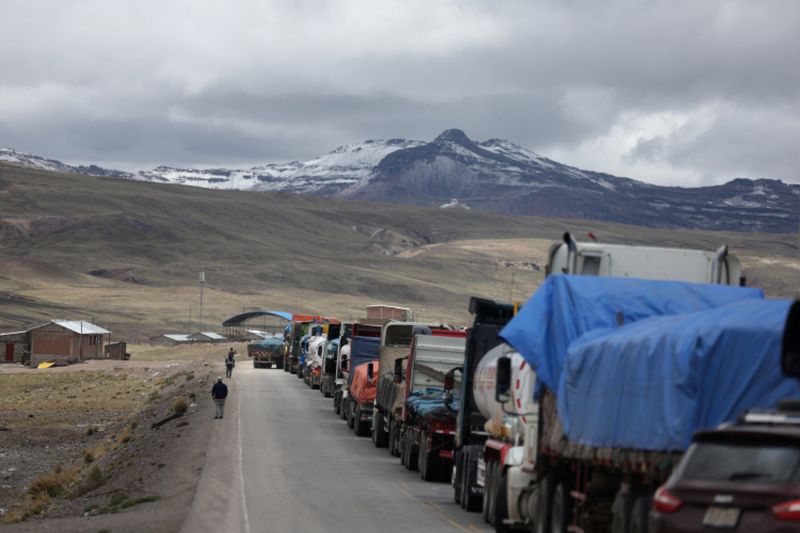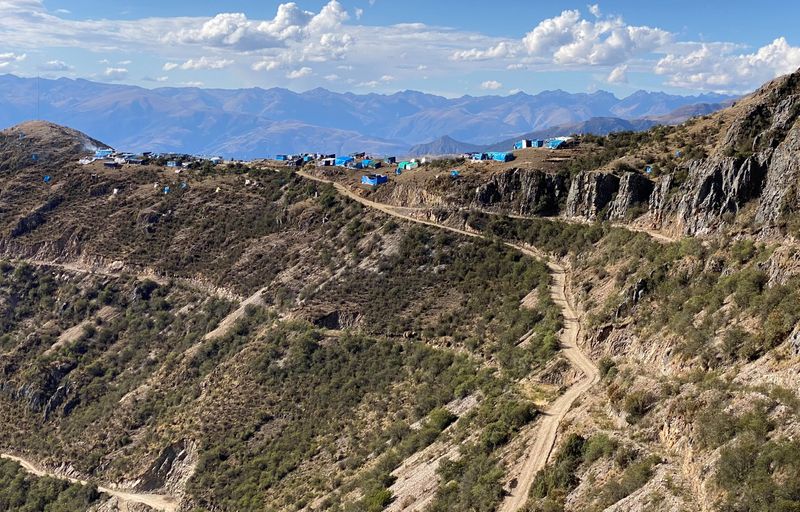By Alexander Villegas and Adam Jourdan
ESPINAR, Peru (Reuters) - Peru's biggest copper mines have been able to maintain production despite road blockades, attacks and protests that have roiled the Andean nation for over two months and led to warnings of production halts, an analysis showed on Wednesday.
The analysis of power usage data by Reuters at some of the key mines in Peru, the world's no. 2 copper producer, indicates that activity at the deposits remains near normal levels, although a source close to one major mine said the risk of stoppages was rising.
The South American nation has been gripped by anti-government protests since the Dec. 7 ouster of leftist President Pedro Castillo. Highways have been blockaded throughout the copper-rich south, threatening production and transport of the metal, hitting some company shares, and boosting already high prices.
But the data suggests mining activity has been resilient, at least for now.
This includes massive deposit Las Bambas, owned by China's MMG Ltd, which previously said it would have to halt production from Feb. 1, and Glencore (OTC:GLNCY)'s Antapaccay, which stopped production in mid-January but has since resumed.
The power data from COES, which represents firms in Peru's energy sector, shows that nearly all major mines are drawing normal or near-normal levels of electricity. The data has traditionally been a reliable indicator of mining activity.
GRAPHIC: Peru Mines: Power use (https://www.reuters.com/graphics/PERU-MINING/zjpqjwqokvx/chart.png)
A source close to Las Bambas said the mine, which previously said it faced a production halt from Feb. 1 due to key provisions not reaching the mine, said it had been able to keep operating at a minimum level after getting "last minute supplies."
The mine, which normally supplies some 2% of global copper, has been hit by regular blockades for years, usually causing its power use to fall sharply during the periods of disruption. This has not yet happened this time around, despite the protests.
The person added, however, that the mine risked fully running out of supplies by Wednesday, which would force it to move into a "care and maintenance" mode with its machinery that would use half the normal level of power.
GRAPHIC: Las Bambas: Power and protest 9https://www.reuters.com/graphics/PERU-MINING/gdvzynngzpw/chart.png)
The data shows some mines experienced temporary dips in power use in recent months, including Peru's largest mine Antamina, co-owned by Glencore and BHP, and Glencore's Antapaccay around the middle of January.
Antapaccay reopened on Jan. 31 after a temporary halt and has been operating again at full capacity.
Hudbay Mineral Inc's Constancia mine has seen power use start to decline recently. Others, like Freeport-McMoRan (NYSE:FCX)'s Cerro Verde are at normal or elevated levels. A combined index of six key mines is near normal.
Freeport-McMoRan spokesperson Linda Hayes said: "We are continuing to operate, but have limited our mill throughput by about 10% to deal with intermittent supply disruptions."
The other firms did not immediately respond to requests for comment about activity at their mines in Peru.
The mining activity is key to keeping global copper supply flowing. Brokerage Jefferies said in a Jan. 31 note that some 30% of Peruvian copper supply was at risk from the unrest, a "potential positive for the copper price."
The protests - which have led to the deaths of 48 people and are the worst violence Peru has seen in over 20 years - could of course soon start to have a greater effect on mining operations. Demonstrators are becoming more determined as lawmakers struggle to agree on calling snap elections, a key protest demand.
This week, Peru's Buenaventura suspended operations at a key silver mine after protesters invaded the site.
At a blockade on the "mining corridor" highway, protester Wilber Toco Aragua Salcedo told Reuters that people felt like the mines took all the wealth and left little for locals.

"The south is quite rich, but the mining concessions that we have harm the people," he said, adding he had heard mines were stocking up on supplies. "The people do not get tired, the people won't go away, we will not take a step back."
GRAPHIC: Peru: mines and power 9https://www.reuters.com/graphics/PERU-MINING/byvrlkoxave/chart.png)
